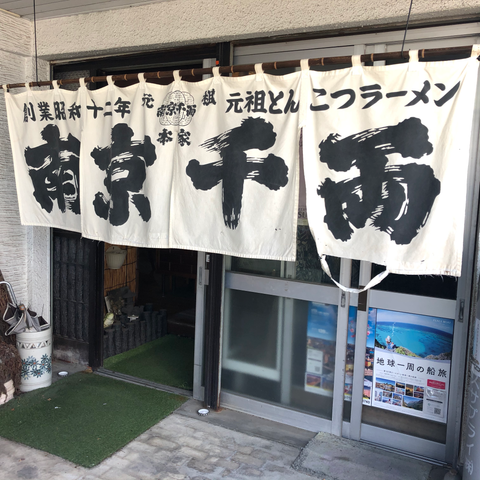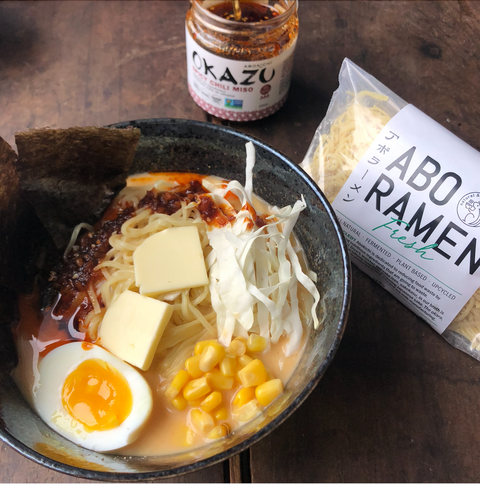There is a special place in my heart, and my mouth, for ramen. I love it! Now as we are preparing to launch our own new healthy version, ABO Ramen, I’d like to share a bit of the inspiration for its creation as well as bring light to the style of ramen that I grew up eating in Kyushu.
There are many regional varieties of ramen throughout Japan. The table below shows a basic breakdown of the ramen styles from the north of the country to the south. This list is not exhaustive as I may have missed some, and experimentation is going on all the time.
Ramen by Region

As you can see, Tonkotsu ramen (pork bone broth) is mainly seen in the southern area of Japan. It was first created by Tokio Miyamoto-san at his yatai (outdoor food stall) in Kurume, a city in Fukuoka prefecture, December 1937. He later went on to establish a brick and mortar shop called “Nankin Senryo”. His family continues to operate this shop on Meiji Street in Kurume.
“Accident is the name of the greatest of all inventors.” - Mark Twain
The modern-day Tonkotsu broth that is served in many restaurants, with more of a whitish colour than Miyamoto-san’s original recipe, was developed accidentally by Katsumi Sugino-san, the founder of a ramen shop called “Sankyu” in Kurume in 1947. The story of his discovery goes that one day when he went out shopping, leaving his mother in charge of the shop while he was gone, he returned to find that the soup was boiling and had become white in the process of overcooking. He believed that this broth would not be sellable, but in an effort to save it, he seasoned it and found that this version had super umami and was much tastier than his original recipe.
After Sugino-san’s amazing discovery, Sankyu became very popular. In the years that followed, over 100 cooks have learned his technique. Many of these cooks went on to open their own Tonkotsu ramen shops all over the island of Kyushu and in Yamaguchi prefecture on neighbouring Honshu island, and it became a popular ramen style in Japan.
Tasting the 84 Year Old Recipe for the First Time
I went to Nankin Senryo to experience the original Tonkotsu flavour. The third generation owner, Hiroshi Miyamoto-san, has held onto the tradition really well. When I tried the ramen, my first reaction was "really mild and delicious flavour".

I tried several ramen stores when I was in Japan last year and this one had the mildest and simplest flavour. It tasted like something homemade. I felt an enormous respect for that because it is very difficult to ignore trends and to keep traditional flavours.
Salty Rich Umami
The current ramen flavours we eat in restaurants are very rich. Super rich. So for a person like me, who cannot live without strong umami flavours, it’s so delicious! Also, ramen is typically very salty. Salt makes everything tasty. The real challenge is how to make food taste delicious without needing a lot of salt.
The following article outlines how a typical bowl of restaurant ramen can be very high in sodium and carbs:
The family from Nankin Senryo is keeping the original flavour. This could be hard for them because in the history of their ramen store, they have very likely faced competition from newer stores, serving ramen with stronger and richer flavours. There must have been pressure for them to make their ramen more rich to align with modern consumer demands, but they resisted the pressure which is noteworthy and commendable.
*This is a Yatai picture I took in Hakata, Fukuoka.

Inspiration for a New Ramen
The experience of tasting the original Nankin Senryo ramen became the inspiration for the recipe development of ABO Ramen. I realized that we want to make something that is as close to “made at home” as possible for people who care about their health.
Modern ramen is really umami rich, salty, and often full of animal fat (great bone broth!). Living in Canada, I still go to ramen restaurants every month. I LOVE LOVE LOVE them. When I was a corporate worker in Tokyo, I was eating ramen for lunch often, sometimes everyday until I noticed that I was gaining weight, and so had to cut back. Ramen is so tasty, but it, and a lot of other restaurant food, just isn’t very healthy for you. When I feel really tired or have worked hard, I would choose to eat ramen in a restaurant over choosing sweets.
Now, I needed to make a ramen recipe for Abokichi. Abokichi is not a restaurant, it is a CPG (consumer packaged goods) brand that assists everyday cooking at home. Because of this, we try to make products that have appealing nutritional profiles. Therefore we cannot sell the same kind of meals that are served in restaurants because while the taste is amazing, the nutritional panel would be extremely off putting for consumers.
In developing ABO Ramen, we came up with the following criteria:
- Use ingredients that are REAL FOOD. Our business started from the farmers market, so I am always asking myself this: “Can I sell this in farmers markets?”
- We prefer minimally processed food. So our instant ramen cannot use powder broth made in a big factory like other instant ramen products. At the same time, we cannot use additives to make the nutrition panel more attractive.
- Plant-based since we have many vegan customers.
- Gluten-free ingredients since some of our customers are celiac or have other gluten sensitivities.
- Aim for fewer carbs. The keto community is one of our big supporters. Making keto-friendly noodles from just real food sounds impossible, but can we reduce the carbs as much as possible?

The Ramen You Can Eat Everyday!
If you aren’t that concerned about your salt, carb, and fat intake and just want to enjoy strong umami flavour, an occasional visit to a ramen shop may suit you fine. They are usually small businesses that require your support too. I love visiting ramen shops, but since I just want to eat more ramen, and maybe you do too, there is ABO Ramen. ABO Ramen is the ramen you can eat everyday. The ramen that has good nutrition values and good umami flavour but is different from the regular ramen.
This is the ramen born from the needs of health-conscious consumers. When we interact with our customers, we hear many health concerns but also they don’t want to sacrifice flavour when choosing products. I am so happy to present the first version of ABO Ramen. If you are a long-time customer, you probably already know that we are constantly experimenting and innovating our products. We are a company that just enjoys making tasty products using lesser-known ingredients. New flavours and maybe even an ABO Ramen 2.0 will surely follow, I think because that’s our nature. So please try and enjoy ABO Ramen, and stay tuned!




